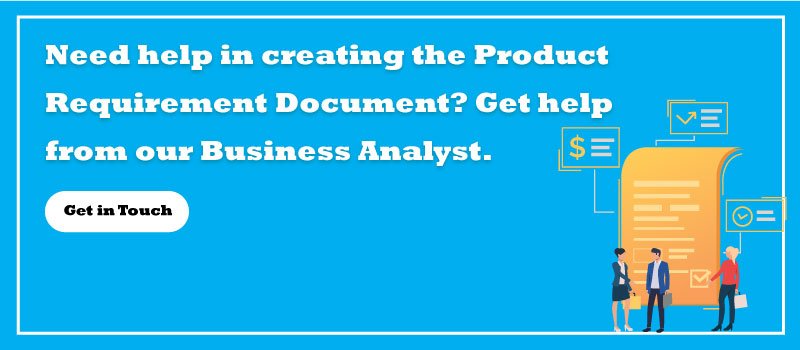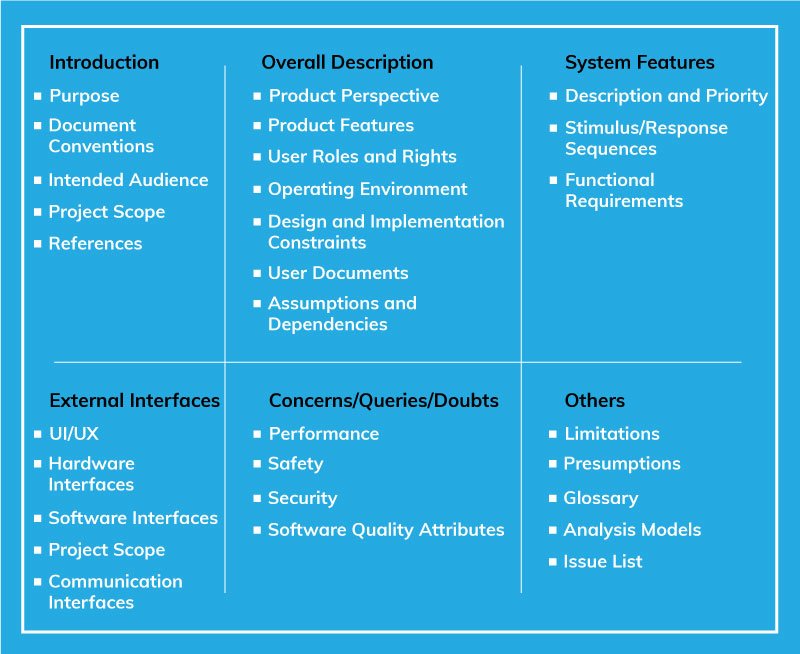Starting from the mobile app idea conceptualization to app development, a detailed vision is all that you need to start the journey of making your app idea the next big hit, especially when you are outsourcing the development of your mobile app. But without having the vision written in a detailed Product Requirement Document, it will be cumbersome for you to vividly express the idea to the potential investors or the technology solution provider that you will outsource your app development too.
You can convey the app idea verbally to the development teams or to persuade an investor for seed funding, but there are several downsides to this kind of approach. Firstly, your dedication and commitment to the project is not likely to be rated highly. This is especially true of investors. Secondly, it is well known it is hard to keep a verbal message consistent when it is passed through several different individuals and channels. It is not uncommon for the end product to be very different to what the founder envisioned when a product requirement document has not been created.
Hence, it will be a waste of your time and money if you directly jump onto developing your mobile application without sharing the detailed documented requirements with the development company. Verbally communicating the app idea often leads to misunderstanding, which ultimately reflects on the end product. These misunderstandings can be eliminated by creating a detailed product requirement document for your mobile app. The requirement document is considered to be the first step of the mobile app development process.
Before diving deeper into the essentials of preparing the product requirement document, let’s understand the types of requirement companies often have for mobile application projects.
Types of Requirements
In a general sense, there are five types of requirements companies have for mobile app development project outsourcing:
- Business Requirements
- Market Requirements
- Functional Requirements
- Non-functional Requirements
- User Interface Requirements
Business Requirements
Business requirements are very crucial for the app owners as they define both the short-term and long-term goals that their organization wants to achieve via the mobile app. It is recommended that you put the business requirement on a single page in a bulleted list that will enhance ease of readability.
Market Requirements
Market requirements act as a supplement to the business requirements. Depending on the market niche, the list can be quite long (up to five pages) and should be written keeping the priorities into consideration. This section will consist of details about the end-user, competitors, and other external market forces that seem relevant for the mobile app.
Functional Requirements
These requirements describe the desired app functionalities and illustrate how the product will work. You are supposed to write every single function you can think of. For example, you can state that “The app should have QR-code payment functionality.” You will be thinking about the user journey and the features that are associated with it. The more you elaborate, the better it will be for your developers, as they will now have a significantly enhanced understanding of what you actually need.
The best practice for listing functional requirements is to prioritize them first. Of course, not all the features will be essential. Identifying this is important if costs are a major concern, as you may have to remove some of these non-essential features to remain in budget.
Non-Functional Requirements
As the name suggests these requirements have nothing to do directly with the app functionality. Instead, they are focused on the non-functional goals. App owners often skimp on writing non-functional requirements, which is a mistake that can lead to undesired product characteristics including security, scalability, integration.
For instance, you want your app to be seamlessly integrated with your accounting software. But you don’t mention this requirement in the document. In this case, you will have to ask developers to put extra efforts in to perform the integration, which eventually will put a dent onto your budget. Hence, proactively defining such non-functional requirements will ease out your mobile app development.
UI/UX Requirements
The User Interface and Experience is directly related to your company’s brand identity. If you already have implemented brand identity throughout your marketing channels and customer touchpoints, you certainly will want the app to have a similar look and feel. Thus, you should include them within the product requirement document.
The Essentials of A Product Requirement Document
The list of essential sections in a product requirement document can be a life saviour for your dream project. The below-mentioned essentials will help you avoid unnecessary changes and multiple iterations in the final product. In addition to eliminating ambiguity, these essentials will provide a clear picture of the project scope, timeframe, specifications, and features. The following are the points you should include in your product specification document.
Goals and Purpose
This section of the document should describe the purpose behind building your mobile app, the problems that your app will solve, an overview of features that are prime, and the end-users. So basically, you will be summarising the idea behind creating the app and the purpose it will serve, which will give a basic understanding of the project to the mobile app development company.
User Persona
Before reaching out to the mobile app development company for the development phase, you probably have already performed the market research for your mobile app. This section requires you to note down the description of your target audience. Here you’ll be describing what the end-user wants from an app similar to yours, what user pain points your app alleviates, how the user will use your app, etc. This section will also consist of target audience details such as gender, age, occupation, education, and geolocation.
Functional & Technical Specifications
As discussed in the earlier part of the article, requirements are the core of every product requirement document. We’ve already discussed these requirements, so I won’t be talking about them in detail. However, I’ve compiled a set of examples for you to help you understand it better.
| Functional Requirements | Technical Requirements |
| Business Rules | Platform Compatibility |
| Admin Functions | OS Version Compatibility |
| Authorization levels | Maintenance Support Requirements |
| External Interfaces | Particulars related to services, server, and database |
| Historical Data Handling | Analytics System Requirements |
| Reporting Requirements | Developer Account Credentials (if already in place) |
| Audit Tracking | Scalability Requirements |
User Stories
User stories are made of the high-level interaction of the users with your mobile app. It is written in a manner that provides the developers with an overview of the expected user behaviour and journey. With this, the developers can see the mobile app from the end user’s perspective, which eventually helps developers to create the best suitable Interaction Design and User Experience.
User Story is a very small piece of work that outlines the value that will be delivered to the end-user during the sprint.
Here is an example of user stories for a dating app:
- As a user, I want to add photos conveniently so that more people can see how awesome I am.
- Being an admin, I want the authority to delete or block users to make sure that only real profiles exist on the platform.
- As a user, I want to be able to add short clips about my guitar playing skills.
There can be innumerable user stories for an app, of course, you cannot include all of them, but you should note down the ones that you feel are crucial for the developer to know at an early stage. User stories can be divided into multiple sub-stories that can potentially describe the app features in detail and features that may not have been defined in the product requirement section.
Sitemap or Flow Diagram
This section of the product requirement document showcases the list of screens that will reside various functionalities. It will include the flow diagram of screens that help the developer understand the navigation of the app. The flow diagram format is often used for mapping out the mobile app sitemap. It eliminates the possibility of ambiguity due to related pages encountering connection in the sitemap. The systematic structure will help you find out unnecessary components and the flaws in the user journey.
Product Wireframes
Wireframes are the best way to visualise the mobile app idea. However, it isn’t necessary to include the perfect wireframes in the product requirement document but, If you have the resource to create them, you should do it. They eliminate the gap between your app idea and the developer’s understanding.
For starters, you can include your hand-drawn wireframes in the product requirement document. Later, you can also ask the mobile app developing company to provide you with professional mobile app wireframes during the UI/UX designing phase. This will help you improve the clarity of your app idea.
Include Assumptions
Presumptions include the assumptions which are related to the business, users, and technical resources required for the app. In this section, you will note down the expectations for the ready product in relation to the current market niche and user base. The following are the examples:
- X% of the users will find enough value in the app to become regular users
- The app will be launched before ________ date
- The technical requirements will work best on the latest OS
Provide Limitations
The market is ever-changing, and it puts the potential app growth at risk if it isn’t launched on time with the right set of features. Therefore, to ensure that you make the most out of your app’s potential impact, you must include the possible constraints, required resources, and budget of the project, so that everything is well taken care of.
Structure of A Product Requirement Document
Conclusion
Always keep in mind that the best product requirement documents are adaptive. This may sound counterintuitive, but it isn’t easy to create a perfect product requirement document. Therefore, I recommend you to follow the structure and guidelines specified in this article. The document will start with a basic idea about the mobile application but as you move ahead, you will be required to be more specific about the features and technical specifications.
The goal of this document is to provide the foundation for a successful project. It will give the development team enough ammunition to get your project off the ground. However, no matter how precise you become with the document, there will always be questions from the developer’s side. The quality of your product requirement document will allow them to come up with intelligent questions that will also help you improve your app idea and understanding of how to optimize your app for your customers.
We, at Nimble AppGenie, know the importance of product requirement documents. Thus, we help our customers with the creation of this document. Feel free to reach out to us with your app idea. We’ve helped many startups in their need for technical expertise and support.

Udai Singh is a senior content writer with over 6 years of experience in creating content for FinTech, eWallet, EdTech, and App Development. He is an expert in simplifying complex concepts and creating engaging content that resonates with the audience.
Table of Contents














No Comments